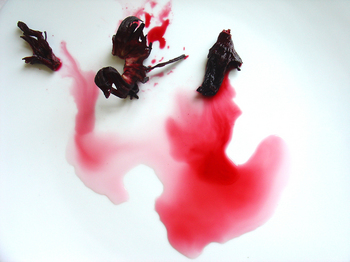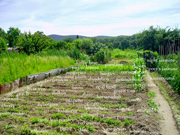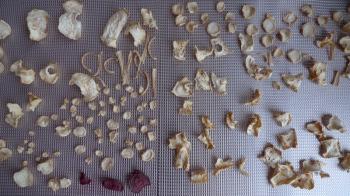A grain of salt: holiday gifts for under 5 euro
December 21, 2004
In just 3 days I will be one of the extended friends of family at an English Xmas celebration. This could be just the chance I’ve been waiting for to initiate a salt and fleur de sel tasting. It’s the thought that counts, right?
Fleur de sel (salt flower) is the term for the “young” crystals that form naturally on the surface of salt evaporation ponds. They are hand harvested under specific weather conditions by traditional paludiers (salt farmers). Purists would say that true fleur de sel could only come from the Guérande region of France, on the isle of Ré. Impurists know that salt is harvested all over the world and that the purists are just trying to market their particular brand of salt.
Fleur de sel is considered to be a ‘finishing salt’, a salt that is both rich in regional flavour and not too concentrated and therefore the perfect salt for sprinkling on salads and steamed vegetables. I have read (but have a hard time believing) that the term fleur denotes the violet-like aroma of the ripening crystals in the ponds. If this were true I’m sure the French would not hestiate to call the crystals violets de sel.
I borrowed this text from this website to describe it.
Fleur de Sel is an all natural sea salt from Brittany France. Unprocessed, unrefined, unadulterated. This salt is unlike any you’ve ever tasted, more like a condiment than a spice, it highlights food flavors and is never too salty, in fact it is almost impossible to overdo it. That is the simple and delicious truth. How it is made is much more difficult.
In Brittany near the town of Guerande are marshes and low lying areas suitable for salt fields. There is a mini climate that is much milder that the rest of Brittany. The currents of the Atlantic run cleaner there than many salt harvesting locations. This confluence of nature makes for an ideal area for a salt farm region. Guerande has no peer in Europe for the quality of salt produced.
The salt fields of Guerande are long and narrow so that an artisan paludier (craftsman salt harvester) can sweep the top of the evaporating sea water to harvest the precious sel gris de Guerande (hand harvested salt with a grey cast). On warm breezy afternoons when there is no rain, that single day’s evaporation of salt crust on top of the salt pond is harvested as the Fleur de Sel. It is the least salty, purest part of the saline. The harvest is usually May to September. For every 80 pounds of sel gris produced, there is one pound of Fleur de Sel that is harvested.
The taste of Fleur de Sel is the complex balance of the sea and her minerals with small flakey crystals, a moist texture and slightly grey/pink cast. It is used to finish a dish. It is a natural compliment to fresh raw vegetables and salads.
The text below is from the US Saltworks website.
Grey Sea Salt has been hand harvested from the clay bottoms of the French Atlantic salt marshes each summer since the seventh century. The salts aroma is redolent of the clean sea surrounding the Island of RĂ©. The island’s salt marshes have been designated “Site remarquable du gout”, an area of outstanding taste, by the French National Council for the Culinary Arts. Gathered with wooden tools as it has been since the Middle Ages, Esprit du Sel’s Grey Sea Salt retains calcium, potassium, magnesium, copper, iron, and iodine for good diet, and nutrition. Neither treated nor washed, it’s totally natural. Professionals use this salt to add complex taste and enhance the natural flavor of food. It is excellent for grilling meats and vegetables or to enhance the flavors in soups.
debra at 16:50 | | post to del.icio.us
















